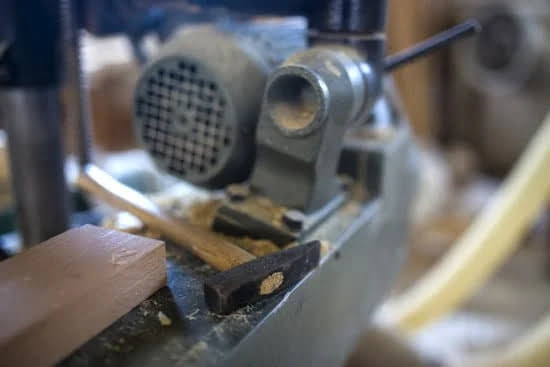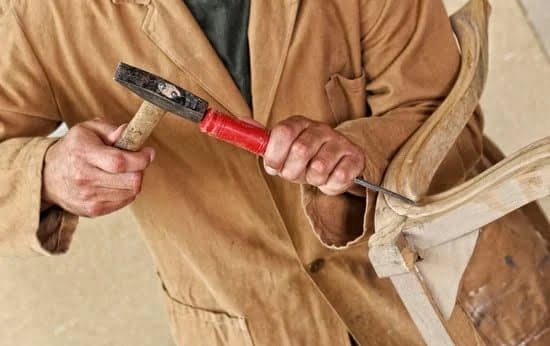Introduction
Fine woodworking is the practice of crafting wooden furniture, artwork, and other items from raw materials using a wide variety of tools and techniques. It typically involves the construction of intricate pieces, often involving complex angles, curves, joinery or inlays. The final product may be used for functional purposes such as furniture, cabinets and shelving; aesthetic purposes such as sculpture and art; or even conservation purposes to protect vulnerable archeological artifacts.
When first starting out in fine woodworking, it is essential to have the right setup. A solid understanding of the basics will help a person focus on more detailed projects while avoiding mistakes along the way. Setting up shop includes gathering essential tools such as saws, planers, routers, chisels, clamps and more. It also requires setting up work benches at appropriate heights and angles to facilitate those critical operations like joint-making and cutting dowels accurately. Additionally, it helps to develop an efficient workflow that allows projects to move quickly from one stage to another without wasting time or resources. Finally, developing a system for sharpening blades helps keep tools performing at peak efficiency over time for safe and attractive results each project. Establishing an organized shop means every piece created will exceed expectations with greater ease each time!
Setting Your Workshop up For Success
Creating a well-functioning wood working shop takes time and patience. It’s important to make sure your workplace is equipped with the necessary tools and machinery to fit the type of projects you’re interested in. Whether you already have a workspace or plan on building a new one, there are several essential steps needed to be taken when setting up your wood working shop.
One of those steps is determining what tools you will need for the types of projects you wish to undertake. Essential pieces of equipment include saws, planers, sanders, joins, jigsaws and other hand tools depending on the job. Make sure that these tools are secured properly to minimize damage from accidental drops or faulty movement as this could potentially cause injury or destruction of materials. Once the main power tools have been installed it’s also important to think about additional workshop items like lighting fixtures, benches, wheeled carts and storage containers for safety and comfort purposes.
Furthermore, good workshop safety practices must be put into place; this means having first aid kits available in case of accidents or incidents along with proper ventilation systems to remove any hazardous dust particles that accumulate during work sessions. Investing in personal protective equipment (PPE) can also help reduce risks throughout everyday tasks by safeguarding your eyes, hands and body against any potential hazards found within the shop environment.
Finally, it’s important to ensure your workshop has all the necessary space needed for full set up and execution of projects without feeling cramped or cluttered . This requires adequate built-in shelving for organization and thoughtful layout configurations for acceptable physical mobility within your space. Taking measurements before investing in furniture will better guarantee productivity during work hours versus spending energy moving unnecessary items around after time has already been allocated towards it!
Choosing the Right Tool Set for Your Shop
When setting up a woodworking shop, it is important to take into account the type of projects you plan on working on and the specific tools you will need. If your shop will primarily be used for furniture building or other large-scale projects, consider investing in power tools like routers, table saws, jointers, band saws, and sanders. Since these are usually more expensive than hand tools, it would be wise to purchase them from a reputable retailer that offers warranties and guarantees.
It is also essential to purchase the right accessories for your tools”including tables and stands for larger machines such as table saws and drill presses. Depending on the size of your workshop, it may be possible to install multiple smaller pieces of equipment (e.g., miter saws, jigsaws) simultaneously so that all types of cutting can occur in one area instead of moving them from station to station based upon usage. Other accessories necessary for successfully completing jobs include clamps and vises for holding material in place while being worked on. Additionally, purchasing sharpening stones and honing guides will help maintain sharp edges on saw blades and chisels respectively throughout their life span. Lastly, having an ergonomically designed workbench with good lighting will allow you to work comfortably without unnecessary strain or fatigue in your workspace.
Establishing an Efficient Workspace
Setting up an efficient workspace is essential for any woodworker looking to produce quality pieces. A well-organized shop can have a big impact on your productivity and enjoyment of woodworking. When planning your woodworking setup, it’s important to consider the size of your space, the layout of the room, storage needs, and function-specific tools.
When choosing the size and layout of your shop, you should start by assessing how much space you have available. If you have sufficient space to work with, consider placing your larger power tools such as your table saw close together and outfitting the area with plenty of outlets and lighting. This configuration allows quick access to each machine while ensuring that dust collection systems are close enough to capture airborne debris immediately.
The right storage solution will help keep clutter out of your workspace. Consider shelving units or cabinets that offer plenty of square footage to store tools and materials while still leaving open space in which to work. In addition to providing dedicated space for tools and materials, installing locking mechanism can keep them secure while they’re not in use.
Finally, a good workshop must be kitted out with all the right tools in order to get certain jobs done properly! Investing in specialized cutting tools like handheld routers or tenon saws is necessary for producing intricate wood designs ” so make sure you include those into your plans when setting up shop. It’s also a good idea to consider investing in some safety equipment such as ear protection before beginning work – this will ensure that you won’t experience hearing damage from loud machinery!
Selecting the Best Lighting For Your Shop
When selecting lighting for a new or existing workshop, it is important to consider the size of the space and how much light is necessary to set up an efficient work area. It is also important to account for any shadows that could be cast while working in particular areas of the shop. Natural lighting from open windows and skylights can help to create a brighter and more efficient work environment, but cannot always provide the necessary level of illumination for complex tasks. In order to ensure that the shop has adequate lighting for both day- and night-time projects, supplemental lighting sources should be installed.
The best way to accomplish this goal is by mixing natural and artificial light sources whenever possible. This will help create even illumination without overly brightening any given area of your workspace. It is also important to try to avoid glare when placing additional lighting in the shop, as this can cause distractions or strain on eyesight in certain settings. Different types of bulbs with different strengths can be used to create layers of light throughout the workspace which helps eliminate any unwanted shadows while providing optimal visibility throughout all key areas of your workshop. Fixtures should also be placed at various points throughout the space so that no corners are left untouched with darkness or dimness. By selecting fixtures that have adjustable levels, it makes it easier to fine tune each area’s brightness accordingly depending on what kind of project is being worked on at that time without needing additional lamps or dimmers scattered around the shop floor.
Fostering a Creative Design Plan
When setting up a woodworking shop, it is important to consider the creative process as well as the practical elements. Take some time to think about what type of projects you are likely to make and map out the best design for the space. Determine where tools should be placed, how workbenches and shelving units should be arranged, and any other features you would like to include. Use resources such as magazine articles, magazines, books or online plans for inspiration and ideas. Consider keeping an organized record of every tool and item in your shop so that you can easily find what you need when starting a new project. Additionally, make sure that your workspace is comfortable with adequate lighting, ventilation and climate control. Having an well thought-out plan can significantly reduce stress when working in the shop while allowing plenty of room for creativity during the designing process.
Streamlining Storage and Maximizing Space
When it comes to creating a woodworking shop, having an organized and efficient layout for storing materials is essential. The main goals when setting up the shop are to maximize space and create a streamlined workflow from tool to project, enabling the workspace to be used as efficiently as possible.
One of the most convenient ways to maximize storage space is through shop shelving. Wall-mounted shelves provide easy access to all your tools and materials, while also keeping everything you need within arm’s reach. Additionally, hanging pegboard or slat wall systems can be installed for additional storage capacity and extending shelf life.
Alongside shelving, it is important to think about how tools and processes are linked together so that they are more easily accessible and don’t need to travel far between steps. This could include having an area close by designated solely for sanding that can quickly become accessible without needing to reposition other machinery. Furthermore, this will assist in allowing projects to move along much quicker if everything needed is located in one general spot rather than traveling back-and-forth across the workshop multiple times which will save time in the long run!
In addition, when organizing a workshop, consider each individual’s needs while also taking into account potential hazards or safety concerns. Keeping power cords from becoming tangled or items from falling off shelves is always something to bear in mind before organizing your shop. Utilizing proper dust collection solutions such as air cleaners or air filtration systems can ensure a healthy breathing environment for anyone who will be operating within the shop on a regular basis. Labeling shelves or drawers with contents can streamline the process of finding what you need quickly and help maintain a clutter free workbench!
Expert Tips From Professional Woodworkers
Fine Woodworking Setting Up Shop is an invaluable resource for those looking to create their own woodworking shop. Written by experienced professional woodworkers, it provides step-by-step instructions and advice on organizing a shop from the ground up. It covers topics such as how to choose the right tools and build essential workbenches like the classic Roubo bench. In addition, it offers detailed plans for popular jigs and fixtures used to cut precise joinery joints.
The book also covers more advanced topics such as creating efficient tool storage systems, workshop layout plans, dust collection diagrams, and even a guide to setting up a specialized space for recovering hand planes or finishing workpieces. With its clear illustrations, accompanied with helpful tips from professional woodworkers, this guide is an indispensable part of any DIYer’s collection. It will not only help you avoid common pitfalls but also speed up the setup process so that you can start woodworking right away. Whether you’re just getting started in woodworking or have years of experience under your belt, Fine Woodworking Setting Up Shop will equip you with all the knowledge needed to successfully design and set up your shop from scratch.
Comprehensive Checklist Before You Start Working
1) Make sure the shop space is well lit and ventilated: Proper lighting and ventilation are essential to ensure that there is visibility to see projects clearly and potential hazardous toxins in the air are kept to a minimum.
2) Run a safety check on all power tools: Before using any power tools, it’s important to review the manufacturer’s instructions carefully and make sure they are functioning properly.
3) Stock up on safety equipment such as earplugs, dust masks, eye protection and gloves: Wear hearing protection when using loud machines or working close by them. Wearing dust masks prevents breathing in potentially harmful particles created when cutting materials or sanding projects. To protect eyes from sawdust, flying objects, sparks or chips wear safety glasses or face shields. Gloves can be helpful for pulling pieces of wood off the saw table more easily and a leather glove is best for sharp chisels.
4) Have adequate workspace available: Create an ergonomic workspace equipped with adjustable chairs, tool-holding tables, counters, storage cabinets and shelving systems. Make sure to create a workbench that fits certain tasks in mind so you can perform those tasks easily and efficiently.
5) Set up an organized way of sorting tools: Having an efficient way of organizing your tools will save time when preparing to start a project which means less time fumbling around trying to find things. Utilize pegboards, bins, hooks or racks dedicated to each tool type so they’re easy to grab without searching through cluttered drawers full of mixed items. This will keep your shop looking neat while also housing commonly used items quickly and effectively.
A Final Word
Now that you have researched and acquired the necessary supplies, it is time to begin setting up your shop. This step requires careful thought and planning since it will directly impact the quality and safety of your projects in the long run. As you set up your shop, consider where to store tools so they are within reach but safely tucked away when not in use. You will also need to consider work surfaces, layout, dust collection systems, safety precautions and organization methods. Investing some time in properly organizing your shop can significantly improve the efficiency of any woodworking task you take on. Create a workspace that maximizes comfort, visibility and lighting for easy access to materials and good ergonomics for stress-free operation of machinery. Make sure all hazardous equipment has been tested and inspected by a qualified technician before use and ensure that safety gear such as glasses, hearing protection and gloves are worn at all times when working with power tools or machinery. All of these steps come together to create an efficient woodworking space where basic maintenance is relatively easy while tasks move along quickly. By making sure these essential elements are addressed upfront, you’ll be able to enjoy countless productive hours creating beautiful pieces of craftsmanship in the years ahead!

Hi everyone! I’m a woodworker and blogger, and this is my woodworking blog. In my blog, I share tips and tricks for woodworkers of all skill levels, as well as project ideas that you can try yourself.





